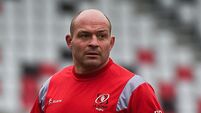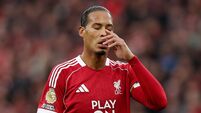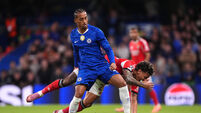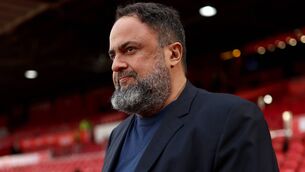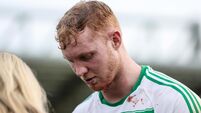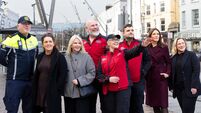Devaney touching the sky

We’re going to be up at 27,000 feet where you can’t survive without supplementary oxygen and oxygen tanks. This is the biggie. You either do it or you don’t.
PaulDevaney hiking in Kerry. Devaney grew up in Longford where he says he certainly ‘didn’t grow up climbing’. In fact the climbing bug struck Devaney almost by accident while he was working in Hong Kong.
Paul Devaney hopes to make his final push on the summit of Mount Everest next month. Pic: Matt Loughrey
hey’ve noticed him without quite knowing him. Man on ladder. Around the University of Limerick, they’ve seen just about every sport under the moon but the way Paul Devaney prepares for his has commanded particularly curious looks.
Munster rugby’s Keith Earls and Anthony Foley have stopped and enquired why he’s so high up on that curving ladder and descends upon it so slowly. To prepare for the ice falls of Everest, he told them, and the eight ladders that span the crevasses separating Base Camp and Camp One.
He learned on Kilimanjaro the dangers of going too fast.
Another time the 36-year-old prompted a bemused Ogie Moran to ask Mr UL Sports Dave Mahedy why was some fella dragging a sledge around the outside running track. Mahedy filled the former Kerry football great in. Climb Everest and Devaney will have reached the highest peak on all seven continents.
Less than 250 people have ever climbed all seven summits. Only four Irish people have. If anyone in UL was literally operating in high performance sport, then it was this mountaineer.
For the past nine months, UL and its altitude house would have been Devaney’s home.
Now it is somewhere on Everest. A fortnight ago he and his reliable wingman Niall O’Byrnes, who has completed five of the other six summits with him, headed off to Nepal, where they’ll stay for the guts of 10 weeks.
They’ve already seen so much of the world before ever seeing the top of it. The snows of Kilimanjaro. The Caucasus of Russia. Alaska. Antarctica.
They’ve nearly encountered death on some of these climbs and on one of them death overshadowed the entire expedition. Yet on they’ve gone, over the mountains.
In a way, mountains have always been part of Devaney’s life. He grew up underneath the highest point in Longford, even if Cairn Hill was still a small hill. There was a tradition of climbing the hill the first Sunday of every June, up to the base of the biggest RTÉ transmitter mast in the country.
Devaney would troop along, reluctantly. “I’d be ‘Why do we have to do this? When will we be home?’ I definitely didn’t grow up climbing.”
Instead he played football for the local club, Killoe and he would still be playing it in 2005 when work as an aeronautics engineer brought him to Hong Kong. He joined up with the GAA team there and found they trained as hard for the Asian championships as a club senior team at home. Someone at work mentioned that with all that hard training done in high heat, he should make the trek to Everest Base Camp.
That’s where he got the mountaineering bug. He might have been sick for days on the trek but once he arrived there the sense of fulfilment and the panoramic view exhilarated him.
On the way up he had been reading a book which frequently mentioned the term Seven Summits. Then just before his return home he and a friend caught a short film at a Hong Kong space museum. It was about Kilimanjaro.
One of the seven summits. “I watched it and thought, ‘I want to do that.’”
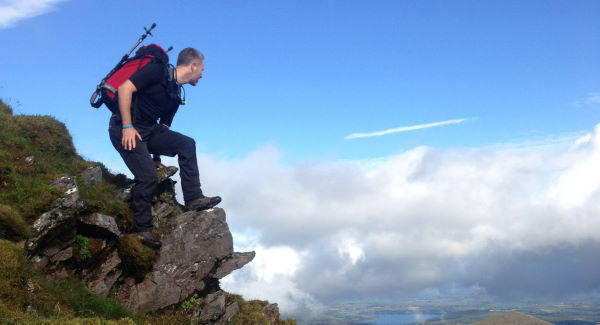
About a year later, a crop of his classmates from UL were all back in Ireland for a friend’s wedding. With most of them dotted across the globe, Devaney saw it as the best window to appeal to their spirit of adventure and travel and so convened a meeting between the church ceremony and the reception. Who wanted to climb Kilimanjaro?
“At the time, it was only Kilimanjaro,” says Devaney in his soft yet extremely assured and articulate manner. “If I touted the idea of seven summits, it would have scared people off.”
A couple of months later he got definitive answers. Five of them were in. Himself. Martin Maher who worked with him in Derby for Rolls Royce. Niall O’Byrnes from Kildare who was based in Europe. And then the two lads from Bantry, Eli Tanner and Alan Whooley, who were back in Ireland.
Kili itself initially went well, too well. The quicker they went, the less they could acclimatise to the lower oxygen. On summit day they were particularly struggling. Then the high of reaching the summit overrode all that.
“It’s a very retrospective sport. Once you reach the top and then once you reach the gate, you forget almost everything about the trip that was miserable. Instead you’ll remember waking up in the morning, unzipping your tent and seeing the clouds below you. After we got down, there was no one saying ‘I’m never doing anything like that again.’ We all got a huge kick out of it. And that’s when I think I piped up ‘You do realise that we’ve done one of the seven summits.’”
The mountains would now become their holidays, “very expensive holidays”, Devaney adds. The question now was which summit should be next? After weighing it all up, they opted for Elbrus in the Russian Caucasus.
To steel themselves they trained extensively in Scotland. “It’s one of the best places in the world to do winter training for mountain climbing. Ben Nevis is like you cut the top off Everest and put it down on sea level in terms of the terrain and conditions. We learned a hell of a lot there but we still knew the wind chill at altitude would be a game changer.”
After flying into Moscow, then into south-west Russia and then driving for hours through the middle of nowhere (“We saw plenty of fields but no animals”) they arrived at the foot of Elbrus.
There were four of them by that point and hardly anyone else. Approaching the summit there were two of them. The two Bantry boys had to turn around.
One was suffering exhaustion while another was fearful the tingling feeling in his fingers could transmute into frostbite.
Halfway up the summit ridge, Devaney himself was seriously wilting. “Niall had to come back down to me and asked what’s wrong. I told him, ‘I’m exhausted.’
So he took out some Lucozade tablets, smashed them together and said ‘Eat these!’ It was completely a placebo but that trigger broke that state I was in.
“Sometimes you just need that gee-up. ‘Come on, we have only another hour to go, then we’re there.’ But also that little bit of tough love: ‘Come on, suck it up. This is not meant to be easy, this is meant to be hard but we’re gonna do it.’
“Too many people don’t. While it doesn’t attract anything like the number of climbers as Kili and Everest too, Elbrus actually has more accidents and deaths. People walk up to it thinking ‘Sure I can climb this in my trainers.’ But you can walk off that mountain in an instant without knowing.”
Devaney almost did, but that training on Ben Nevis and how to stop a fall saved him. They still hadn’t been quite prepared for the cold. When you’d breathe your goggles would be covered over in ice. Their food and drink strategy as well as their gear management was faulty. The water bottles in their bag had frozen, having neglected to insulate them.
“We had intense cold hitting our bodies. But I learned there was a reserve within that I hadn’t been aware of. Yes, there was pain and struggle but we were still able to put one foot in front of the other. So we came away knowing that we had a bit of puff in us that we could count on.”
As part of his prep to climb the highest mountain outside of Asia, Devaney drew up a What-If list for the first time. If anything happened at home or with him away, he left a series of contact details. At the bottom was the instruction, ‘If all of the above doesn’t work, call Steve Mason.’
Steve had been in his class in UL and was now working with him for Rolls Royce in Connecticut. He was reliable, resourceful, a younger version of Harvey Keitel’s Mr Wolf.
A couple of days after Christmas and into the expedition Devaney got a message. Steve Mason had called.
Devaney returned to base camp but it took another couple of hours there before the guide finally plucked up the courage to call him aside at dinner. His father at 64 had died of a heart attack.
Devaney was stunned. His father had hardly been sick a day in his life. Only days earlier they had been talking on the phone on Christmas Day. But the grief could wait; it was now all about getting back home. A helicopter got him off the mountain but the real trouble was getting out of Buenos Aires. His return flight wasn’t scheduled for another couple of weeks. Then he calculated that if he could get to Santiago he could get to New York. But after he booked a flight to Santiago the check-in desk had no record of it. They couldn’t process his credit cards.
“I asked them where the office was. And I jumped across the counter, ran up the stairs, threw all on my credit cars on the table and said, ‘I don’t give a shit which one of those works, I need to get on this plane.’ You’d get tied to the floor if you tried that now but I ended up making that plane, just about.”
It was a Saturday Steve Mason called. It was 6am on the Tuesday Devaney arrived home, the second day into the wake. It was surreal. His father in a coffin in that church which he had helped renovate. Niall suited and booted in the church. It was a long way from Aconagua to Killoe.
They didn’t climb any of the seven summits in 2009 but McKinley in Alaska was the one most firmly in their sights so to prepare for that, they took on Mount Blanc during the summer.
“It was the first mountain we could say we’d enjoyed every minute of it. The experience of the previous two years was really kicking in.”
Before climbing the biggest one in the States though, they got a chance to climb in Australia. Martin Maher, one of the original Famous Five, had emigrated a few years earlier and was getting married there. With Mount Kosciuszko easily the smallest of the seven summits, Devaney and O’Byrnes skipped to New South Wales two days before the wedding before making it back to Melbourne again.
Australia was just a sprint but Alaska was a marathon. An ultra-marathon. Their plane left a little town called Talkeetna before dropping them on the glacier and that was basically the last of civilisation they would see for over two weeks. At one point the US Airforce were flying test planes overhead but Devaney didn’t see them because he couldn’t afford to look up; change of blood flow and focus being possibly fatal.
Only a seasoned, prepared team can survive as tough and as cold a mountain as McKinley. “That was the one we came away thinking, ‘That’s a real expedition.’ We were dragging huge sledges and carrying huge loads and three weeks on the mountain and we made it through.”
All the way up they never spoke about it. Maybe it was because Niall and himself went up the other side of the mountain than they had on that aborted trip three years earlier, but they didn’t mention Dad. But once they got to the summit Devaney produced a little stone from a grave in Killoe and placed it on the highest point in South America. Then he took a stone from the highest point in South America to take back and place in a grave in Killoe. Someone was with them on this one.
After McKinley there was only Everest and the Antarctic left. But to raise the funds to complete them without this quest extending to his late 30s, Devaney quit his job with Rolls Royce in Berlin to give all his time to training for and marketing his mountaineering. “Going for a life goal, you put everything on the table.” After a few months in Dublin he relocated to his alma mater in UL, availing of all its facilities and expertise. By Christmas he was ready for the Antarctic cold.
He was hugely conscious of whose steps he was following in. A month before the expedition he met descendants of Tom Crean and Ernest Shackleton at an exhibition in Dun Laoghaire marking the centenary anniversary of the Endurance expedition. While in Antarctic, he read extensively on Crean. He constantly met Norwegians whose respect for the two Irishmen and their British Navy colleagues was reverential.
“Amundsen won the race to the (South) Pole but because those expeditions are so much part of their historical culture, the Norwegians look at the likes of Crean and Shackleton and Scott as supermen.”
Now so is Devaney’s for that entire region. From the moment he and his team landed on this blue-ice runway at 3am in bright sunlight it was like a magical wonderland.
Everything has just been a build up to this, he insists. People tell him he’s achieved a lot, but for him it’s like the others don’t matter now.
“They’re not even in your head. Everest is going to be such a different mental and physical chore compared to what we’ve done before. We’re going to be up at 27,000 feet where you can’t survive without supplementary oxygen and oxygen tanks. This is the biggie. You either do it or you don’t.”
He’s spent extensive time with people who have climbed it. The week before last, Pat Falvey gave him the loan of a Satphone. He’s met with the three Irish people to complete the seven summits — Clare O’Leary from Cork, Vivian Rigney and the late Ian McKeever, the former AA Roadwatch personality who was tragically struck by lightning on Kilimanjaro last year.
“Ian was terrific. He was particularly interested in our bloods and our irons. ‘Oh you’re going to do this, lads. You’re going to do this!’ Sometimes you need someone to sit down and say that to you.”
You also have to say it to yourself. Devaney has become hugely attuned to a range of mental skills, especially coining some mantras to help him keep plugging along. “I’ve had instances where I’ve said the same thing for five or six hours. All the way up Aconagua I was saying to this particular rhythm ‘I’m going to make it... to the top. I’m going to make it... to the top.’ It might be a form of madness but it works.”
In UL he’d team up with the yoga coach Paulette Egan who helped draft and narrate imagery scripts. He listens in 10-minute blocks daily.
“We’ve one for the very start. ‘You’re leaving Base Camp. You can hear the bells of the Buddhist temples. You’re now walking through an ice fall. This is unusual, vertical ice. You’re crossing the ladders. You have to focus now, watch your feet. Foot straight down on the step. Watch how you raise it...’
“I’m very aware I don’t want my story to end at the summit. From the summit to Camp Four is where all the accidents happen. So I want to get this milestone into my head that arriving at Camp Four is the end of my summit day, that’s when you’ve achieved something. ‘Okay, there are people coming up on the ropes. Watch out for them. You’re tired but you’re going to be picking up new oxygen soon no, so energy is coming. Keep focused, dig in and briefly think of why you need to get back down. Because you’re going to be coming back home to Killoe, the local church, the local GAA field.’”
That’s a while away yet. It won’t be until the jet stream clears sometime around mid-May that he and the others will make their push.
It is going to test every fibre he has. But he’ll be driven on by the fact he’s doing it for a charity called Liam’s Lodge, a child-friendly ambulance service for kids with genetic diseases. And he will tell himself, ‘I’m going to make it... to the top.’







